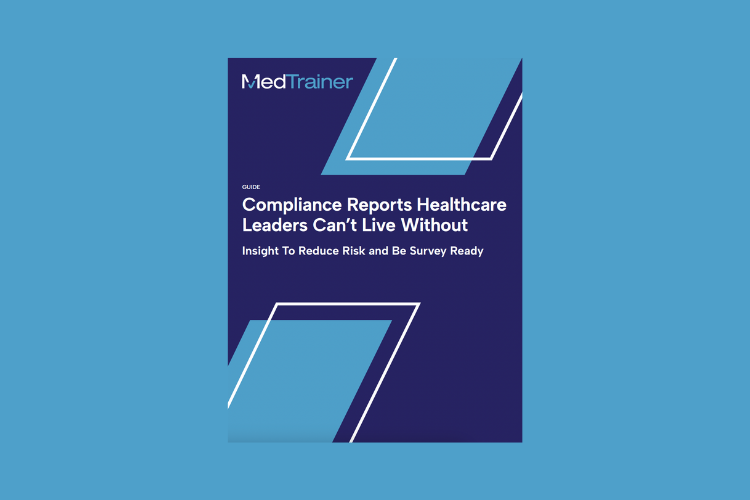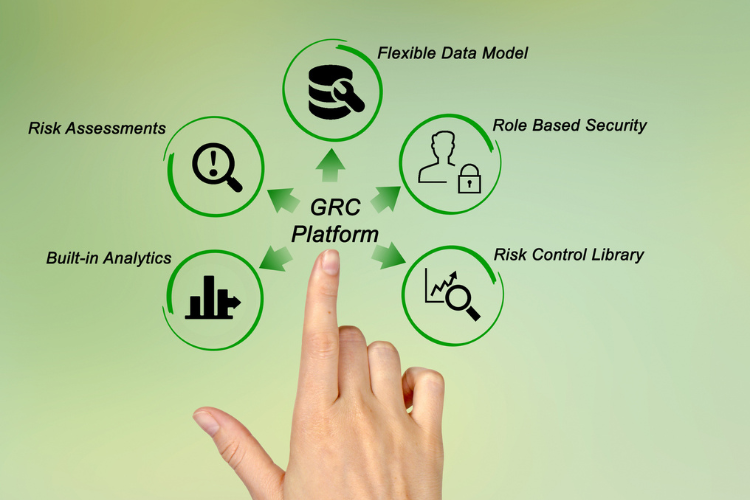Healthcare organization leaders must balance the need for greater operational efficiency while reducing costs and minimizing compliance risk. This isn’t easy in a regulation-heavy industry where non-compliance can lead to severe penalties, including fines and legal actions. Many are discovering how healthcare governance, risk, and compliance (GRC) software helps streamline processes, reduce administrative burdens, and maintain a higher operational efficiency standard.
Consolidated healthcare compliance management software allows organizations of all sizes and types to automate policy management, incident reporting, and regulatory tracking so all compliance-related tasks are performed consistently and accurately. This article will share how healthcare GRC software improves compliance management, what features to look for in GRC software, and how the best solution centralizes functions, is scalable and flexible, refines data management and reporting, and increases operational efficiency.
What Is Healthcare GRC Software?
Healthcare GRC software integrates governance, risk management, and compliance into a unified platform. This framework provides a comprehensive view that has become indispensable for strengthening compliance and safeguarding patient data. Consolidating technology reduces redundancies, improves efficiency, and streamlines compliance monitoring across myriad standards and regulations. The software helps manage three key areas:
- Governance: Supports processes, roles, policies, and procedures for achieving organizational objectives, supporting decision-making, and maintaining accountability. The software helps reinforce decision-making and accountability within the organization.
- Risk Management: Helps identify, assess, and mitigate potential threats impacting business operations, such as data breaches or operational inefficiencies.
- Compliance: Monitors and reports on the organization’s compliance with state, federal, and international laws and standards—a crucial function where regulations like HIPAA require strict protection of patient information.
The healthcare industry is inherently risky, so organizations must adhere to the 600-plus federal, state, and industry regulations to deliver care and receive payment for those services. Many healthcare organizations utilize GRC software to simplify the process of monitoring and managing compliance to help meet regulations and standards.
Additionally, the software aids in identifying, assessing, and mitigating risks, thereby protecting patients, staff, and the organization’s reputation. With the rise of cyber threats, safeguarding patient data has become paramount, and GRC software helps implement robust data protection measures to reduce the risk of data breaches.
Four Ways GRC Software Improves Compliance Management
One key benefit of healthcare GRC software is its ability to centralize compliance management. Traditionally, healthcare organizations have used multiple disparate systems to manage various compliance functions, leading to inefficiencies and increased risk of non-compliance.
Healthcare GRC software consolidates these systems into a single, unified platform, allowing for streamlined workflows and improved visibility across the organization. This centralized approach simplifies the management of policies, procedures, and regulatory requirements, ensuring that all compliance activities are tracked and managed effectively.
Here are four key improvement areas:
Offers Scalability and Flexibility
Healthcare organizations are constantly evolving, and their compliance needs change accordingly. GRC software gives your organization the scalability and flexibility to adapt. The software can scale as organizations grow to accommodate additional tracking and more complex workflows. Additional customizations help it to fit the specific needs of different departments, ensuring that each area of the organization can manage its compliance activities effectively. Integration capabilities with existing systems and technologies further enhance the software’s flexibility, providing seamless data flow and interoperability.
Better Data Management and Reporting
Effective compliance management relies heavily on accurate and timely data. With data available from across all areas of compliance, organizations can monitor and analyze compliance results in real time within healthcare GRC software. Creating comprehensive reports for internal stakeholders and regulatory bodies ensures that all compliance activities are documented and easily accessible, which is particularly important for audits and inspections. A Midwest-based urgent care center struggled to efficiently provide evidence to accreditation surveyors while growing and adding providers at a rapid pace. By implementing healthcare GRC software, administrators can run a report to view completions and ensure compliance across the organization with just the click of a button.
Increases Operational Efficiency
Operational efficiency is key for healthcare organizations to enhance compliance management tools and do more with less. Healthcare GRC software automates repetitive and manual tasks, allowing staff to focus on more strategic activities. For example, having governance, risk, and compliance activities in one platform can greatly simplify new hire onboarding. Administrators can set up required training, policies, and HR forms by role, department, and location, so that everything is assigned with just one click. The software enhances collaboration among departments, ensuring that compliance activities are coordinated and managed effectively and integrations enable platforms to work together.
Reduces Costs While Improving Care
Healthcare GRC software reduces complexity and inefficiencies and cuts operational costs by eliminating the need for multiple-point solutions. For example, most healthcare organizations are using multiple softwares to draft, approve, distribute, store, and electronically sign policies. Eliminating some of these vendors would surely save money on the contractual cost, as well as the staff time that goes into managing multiple vendors. Return on investment can be measured in terms of improved compliance, reduced risk of penalties and fines, enhanced operational efficiency, and better overall governance. Automation is another key cost saver because it frees up staff time to complete other tasks. When staff are not manually checking exclusions monthly, they can reduce risk in other ways, helping the organization avoid fines and penalties.
Watch this webinar to see how an FQHC improved policy management.
Features To Look For in Healthcare GRC Software
When selecting healthcare GRC software, it is important to consider the following features:
- Policy & Document Management: Facilitates the creation, distribution, and management of policies and documents, ensuring that all staff have access to the latest information. This feature helps maintain compliance with regulatory requirements and ensures the consistent application of policies across the organization.
- Incident Management: Provides tools for reporting, tracking, and managing incidents, helping organizations respond quickly and effectively to compliance issues. This capability allows for thorough investigation, root cause analysis, and corrective actions to prevent future occurrences.
- Learning Management: Supports training and development programs to help staff understand compliance requirements and best practices. It includes e-learning courses housed in a healthcare learning management system, tracking of staff training completion, and ensuring that all employees remain up-to-date with necessary certifications and compliance standards. Leading GRC software solutions are regularly updated to reflect changes in regulations and standards. They provide alerts and updates to ensure healthcare organizations comply with the latest requirements.
- Integration Capabilities: Most modern GRC software solutions offer integration capabilities with other healthcare systems, such as electronic health records (EHR), human resource information systems (HRIS), and financial platforms. This provides seamless data flow and interoperability with existing systems and technologies.
- Automation: Automating repetitive tasks and workflows improves efficiency and reduces the risk of human error. This can include automatic reminders, notifications, and task assignments, streamlining compliance processes, and ensuring the timely completion of compliance activities.
- Customizable Reporting: Offers robust reporting tools that can be tailored to meet the organization’s specific needs. It enables the generation of detailed compliance reports, dashboards, and analytics, providing valuable insights for decision-making and regulatory reporting.
- Easy To Use: As your single compliance solution, healthcare GRC software should be user-friendly and accessible to all staff, regardless of their technical expertise. Intuitive interfaces, simple navigation, and clear instructions help facilitate widespread adoption and effective use of the software.
- Support and Training: With just one system, you must ensure the vendor provides ongoing support and training. This includes access to customer service, technical support, and training resources to help staff effectively utilize the software and stay current with updates or new features.
Choose MedTrainer for Healthcare GRC Software
MedTrainer’s healthcare GRC software combines compliance management, a learning management system (LMS), and provider credentialing into one affordable, user-friendly system. Offering multiple products under a single solution makes compliance management accessible to healthcare organizations of all sizes. By eliminating the need for verticalized point solutions, MedTrainer reduces complexity and improves operational efficiency.
MedTrainer healthcare GRC software enables organizations to meet regulatory requirements, mitigate risks, and maintain high standards of patient care by centralizing compliance functions, offering scalability and flexibility, improving data management and reporting, and increasing operational efficiency.
Reviewers on G2, the largest and most trusted software marketplace, named MedTrainer a Leader in Healthcare Compliance Software. MedTrainer Credentialing ranked as a High Performer for the second straight quarter and notched the highest overall score for Quality of Support. MedTrainer Compliance got a perfect score for Product Going in the Right Direction. MedTrainer Learning nabbed Best Results in the Learning Management Software category and was awarded Easiest Setup in the Implementation Index.
See why G2 users are fans of MedTrainer. Request a demo.

